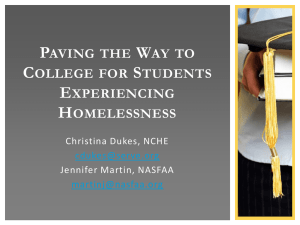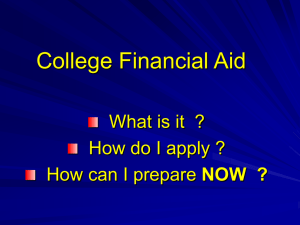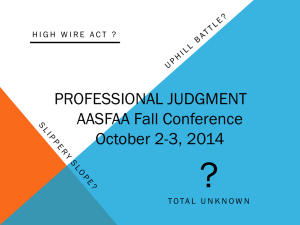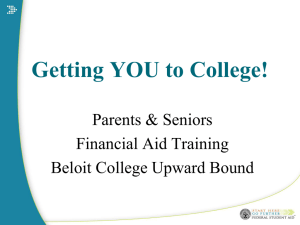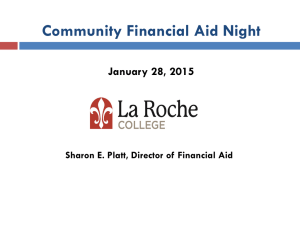Paving the Way to College for Students Experiencing Homelessness
advertisement
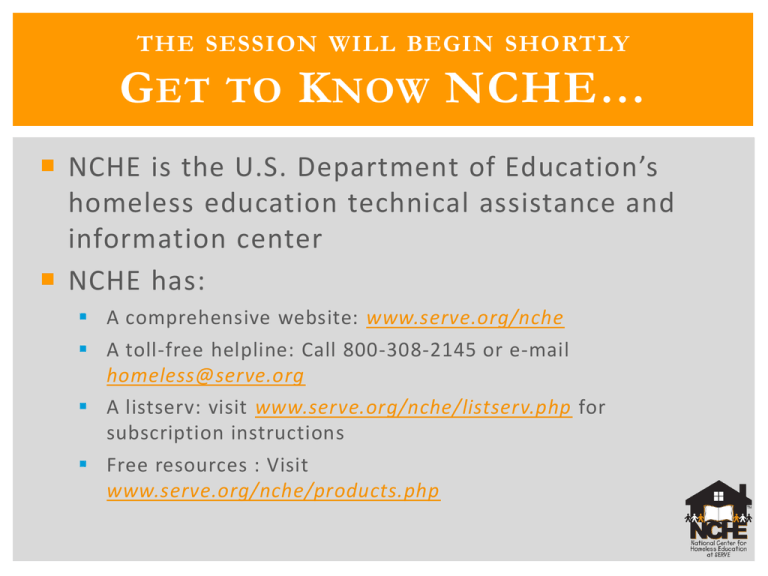
THE SESSION WILL BEGIN SHORTLY G ET TO K NOW NCHE… NCHE is the U.S. Department of Education’s homeless education technical assistance and information center NCHE has: A comprehensive website: www.serve.org/nche A toll-free helpline: Call 800-308-2145 or e-mail homeless@serve.org A listserv: visit www.serve.org/nche/listserv.php for subscription instructions Free resources : Visit www.serve.org/nche/products.php PAVING THE WAY TO C OLLEGE FOR S TUDENTS E XPERIENCING H OMELESSNESS Christina Dukes cdukes@serve.org Jennifer Martin martinj@nasfaa.org A BOUT NASFAA The National Association of Student Financial Aid Administrators (NASFAA) supports the training, diversity, and professional development of financial aid administrators; advocates for public policies and programs that increase student access to and success in postsecondary education; and serves as a forum for communication and collaboration on student financial aid issues. S ESSION O UTLINE Dealing with application expenses Advanced Placement exam fees College entrance exam fees College application fees Seeking financial aid and scholarships The FAFSA for “accompanied” homeless students The FAFSA for unaccompanied homeless students Private scholarships State-specific opportunities Options for undocumented homeless students F OUNDATIONAL D OCUMENTS The McKinney-Vento Act; available at www.serve.org/nche/m-v.php The FAFSA (Free Application for Federal Student Aid), available at www.fafsa.gov The Application and Verification Guide (AVG), available at www.serve.org/nche/ibt/higher_ed.php RAISE OF HANDS What do you consider your current knowledge level to be regarding college access for homeless students? 1. 2. 3. 4. Expert Average Beginner Ummm, what’s college access? C OLLEGE A DMISSIONS C HECKLIST Take Advanced Placement (AP) tests, if applicable Take college entrance exam(s) (SAT and/or ACT) Complete and submit college applications Complete and submit the FAFSA Complete and submit applications for private scholarships More information is available from the College Board: “Applying 101”: https://bigfuture.collegeboard.org/getin/applying “Financial Aid 101”: https://bigfuture.collegeboard.org/pay-forcollege/financial-aid F EE WAIVERS A DVANCED P LACEMENT (AP) E XAMS : Most four-year colleges in the United States and colleges in more than 60 other countries give students credit, advanced placement, or both on the basis of AP Exam scores; however Each college or university is allowed to set its own policy as to which tests they will accept for credit, how much credit they will give, and what score is required to get credit. A DVANCED P LACEMENT (AP) E XAMS AP exam fee waivers are available for eligible students with no limit on the number of waivers per student To qualify for an SAT fee waiver: The student receives or is eligible to receive free or reduced price lunch The student's family receives TANF assistance The student is eligible to receive medical assistance under the Medicaid program Waivers are administered at the school; speak with your school’s AP Coordinator A DVANCED P LACEMENT (AP) E XAMS : A full AP exam waiver consists of: A federal contribution of $53/exam A College Board contribution of $26/exam A school’s waiving of their $8/exam fee Some states may continue to charge a nominal fee More information is available from the College Board: Fee reductions for AP Exams: http://professionals.collegeboard.com/testing/waivers/guidelines /ap 2012 Details by State: AP Exam Fee Assistance: http://professionals.collegeboard.com/testing/ap/coordinate/det ails-state C OLLEGE E NTRANCE E XAM : T HE ACT To qualify for an ACT fee waiver, the student: Must be enrolled in high school in the 11 th or 12 th grade Must be a U.S. citizen (if testing abroad) or be testing in the U.S., Puerto Rico, or a U.S. territory Must meet one or more of the following indicators of economic need: Student is receiving free/reduced lunch Family income is below the USDA reduced-price lunch level Student is enrolled in TRIO or a similar program Family lives in subsidized housing or receives public assistance Student is experiencing homelessness Student is living in a foster home Student is a ward of the state or is an orphan C OLLEGE E NTRANCE E XAM : T HE ACT Student can use the waiver to take the ACT up to two times The waiver is sent to high schools each summer; students must access the waiver from the school counselor, not from ACT The waiver must be signed by the student and school counselor The waiver covers the basic test fees, including sending the test score(s) to up to four colleges; does not cover late registration fees or change fees Additional information is available at http://www.actstudent.org /faq/answers/feewaiver.html A sample 2011/2012 fee waiver is available at http://www.act.org /aap/pdf/feewaiver.pdf C OLLEGE E NTRANCE E XAM : T HE SAT To qualify for an SAT fee waiver, the student must: Be enrolled in high school in the 11 th or 12 th grade (SAT) or in grades 9-12 (SAT Subject Tests) Be a U.S. citizen (if testing abroad) or be testing in the U.S., Puerto Rico, or a U.S. territory Meet one or more of the following indicators of economic need (same as for the ACT) Student is receiving free/reduced lunch Family income is below the USDA reduced-price lunch level Student is enrolled in TRIO or a similar program Family lives in subsidized housing or receives public assistance Student is experiencing homelessness Student is living in a foster home Student is a ward of the state or is an orphan C OLLEGE E NTRANCE E XAM : T HE SAT The waiver must be obtained from the student’s high school counselor or an authorized agency, not from the College Board To be valid, the waiver must be completed by the high school guidance counselor The student can receive up to four waiver cards: Up to 2 waivers for the SAT and 2 waivers for SAT Subject Tests C OLLEGE E NTRANCE E XAM : T HE SAT The waiver covers the basic test fees, including sending the test score(s) to up to four colleges; up to four Request for Waiver of College Application Fee forms, and a $40 discount for the Official SAT Online Course; does not cover late registration fees or change fees College application fee waivers should be included with the students’ college applications and sent to colleges included in the Directory of Colleges Cooperating with the SAT Program Fee-Waiver Service Additional information is available at http://sat.collegeboard.org/register/sat-fee-waivers C OLLEGE A PPLICATION F EES College Board program (mentioned on previous slide) National Association of College Admission Counseling (NACAC) form To be completed with the help of the high school counselor For graduating high school seniors entering college in the fall Based on income and/or the counselor’s knowledge of the family’s circumstances Same eligibility criteria as the ACT and SAT waiver programs Additional information from the College Board: http://professionals.collegeboard.com/guidance/applic ations/fee-waivers Additional information from NACAC: http://www.nacacnet.org/studentinfo/feewaiver/Pages /default.aspx C OLLEGE A PPLICATION F EES Most colleges follow the College Board’s and NACAC ’s guidelines for determining application fee waiver eligibility; however, individual institutions may have their own fee waiver policies that vary Some colleges do not charge application fees for students that apply online NCHE does not recommend using McKinney -Vento subgrant funds or Title IA set-aside funds to pay for AP exam, college entrance exam, or college application fees, as waivers are available Q UESTIONS ? T HE FAFSA RAISE OF HANDS Describe your experience working with unaccompanied homeless youth (UHY) to access federal financial aid? 1. I have worked with UHY; our efforts were successful 2. I have worked with UHY; our efforts were met with resistance 3. I have not yet worked with UHY on financial aid issues 4. Ummm, what’s an UHY? FAFSA B ASICS FAFSA = Free Application for Federal Student Aid The official FAFSA web address is http://www.fafsa.gov Students applying for federal aid must complete a FAFSA for each school year for which they are seeking federal aid A new FAFSA is released each January for the upcoming school year Example: 2012-2013 FAFSA Released in January 2012 Valid for students attending school for Fall 2012 and Spring 2013 Treatment of the Summer term depends on the school C ALCULATION OF F EDERAL A ID EFC = Expected Family Contribution; based on the information submitted on the FAFSA, the U.S. Department of Education will calculate the EFC Dependent Student Must report parent information on FAFSA EFC is based on parents’ and student’s income and assets Independent Student Does NOT report parent information on FAFSA EFC is based on student’s income and assets M C K INNEY-V ENTO S TUDENTS : D EPENDENT OR I NDEPENDENT ? “Accompanied students” experiencing homelessness fill out the FAFSA as dependent students Living arrangement meets the M-V definition of homeless In the physical custody of a parent or guardian M C K INNEY-V ENTO S TUDENTS : D EPENDENT OR I NDEPENDENT ? Unaccompanied youth experiencing homelessness or at risk of homelessness fill out the FAFSA as independent students Living arrangement meets the M-V definition of homeless Not in the physical custody of a parent or guardian 21 or younger or still enrolled in high school on the date he/she signs the FAFSA “At risk of homelessness”: when a student’s housing may cease to be fixed, regular, and adequate, for example, a student who is being evicted and has been unable to find fixed, regular, and adequate housing. A CCOMPANIED H OMELESS S TUDENTS AND THE FAFSA Provide information on parent income and assets and their own income and assets Need parent signature The EFC is based on family income and assets; as such, even though they fill out the FAFSA as dependent students, homeless students from low -income families will likely qualify for a beneficial aid package Example: The EFC Formula, 2012-2013 explains that, under certain circumstances, students qualify for an automatic $0 EFC, including students who received free school meals in 2010 or 2011, and whose parents’ 2011 income is less than $23,000 http://ifap.ed.gov/efcformulaguide/attachments/01051 2EFCFormulaGuide1213.pdf U NACCOMPANIED H OMELESS S TUDENTS AND THE FAFSA Do not need to provide information on parental income and assets Do not need a parental signature Do provide information on their own income and assets Independent status is not equivalent to free tuition; however, the EFC is calculated proportional to what the student can provide based on his/her resources C LASSIFICATION AS “INDEPENDENT” Independent if ANY of these are true: Married 24 years old Veteran or on active duty Graduate student Has a legal dependent (child/other) Orphan/Ward of the court/In a legal guardianship Legally emancipated minor In foster care at age 13 or older Unaccompanied homeless youth Independent by “professional judgment” or “dependency override” as determined by the Financial Aid Administrator (FAA) D ETERMINERS OF I NDEPENDENT S TATUS FOR UHY Local homeless education liaison; for students graduating from high school who were identified as an UHY while in high school (contact your State Coordinator for Homeless Education for liaison contact information) U.S. Department of Housing and Urban Development (HUD) shelter director or designee; for students who have received services Runaway and Homeless Youth Act (RHYA) shelter director or designee; for students who have received services Financial Aid Administrator (FAA); for any student, but particularly those who cannot get a determination from one of the other three authorized parties 2012-2013 A PPLICATION AND V ERIFICATION G UIDE Updated Application and Verification Guide (AVG) released in March 2012 Student can use the college’s administrative address as his/her mailing address Youth = 21 or younger or still enrolled in high school on the date he/she signs the FAFSA Ages 22-23 = need a dependency override for independent status Age 24 or older is automatic independent status T HE R OLE OF THE FAA A CCORDING TO THE AVG If a student does not have, and cannot get, a determination from a local liaison, RHYA provider, or HUD provider, a financial aid administrator must make a determination of unaccompanied homeless youth status If a student meets the definition of UHY, this is not an “exercise of professional judgment” or a “dependency override”; this is determining the independent student status of an unaccompanied homeless youth In instances where a student doesn’t meet the definition of UHY but there are other extenuating circumstances, a dependency override or exercise of professional judgment may be appropriate FAA D ETERMINATION OF S TUDENT S TATUS Verification of “yes” answers on the FAFSA is not required unless there is conflicting information Permits a FAA to determine a student’s status with a documented interview Encourages discretion and sensitivity when gathering information Some information may be confidential (e.g., protected by doctor-patient privilege) Child welfare and/or law enforcement reports are not necessary Recommends consulting with local liaisons, State Coordinators, NCHE, school counselors, clergy, etc. Eligibility determinations may be appealed to the school or the U.S. Department of Education 2012-2013 O NLINE FAFSA 2012-2013 O NLINE FAFSA 2012-2013 PDF/PAPER FAFSA N OTES FROM THE 2012-2013 PDF/PAPER FAFSA R ESOURCES NAEHCY Template (Unaccompanied Homeless Youth Documentation of Independent Student Status for the FAFSA) available at http://www.naehcy.org/higher_ed.html NCHE/NAEHCY FAA Tool (Making Student Status Determinations for Unaccompanied Homeless Youth: Eligibility Tool for Financial Aid Administrators) available at http://center.serve.org/nche/downloads/faa_de t_tool.pdf Q UESTIONS ? S CHOLARSHIPS , S TATE R ESOURCES , U NDOCUMENTED S TUDENTS P RIVATE S CHOLARSHIPS Check with the high school’s guidance counselor for a list of private scholarships available to area students The LeTendre Education Fund Scholarship: www.naehcy.org/letendre_ab.html (application period closed until 2013) Give Us Your Poor/Horatio Alger Scholarship: https://www.horatioalger.org/scholarships / (currently accepting applications) P RIVATE S CHOLARSHIPS Free scholarship search engines: Fastweb!: http://www.fastweb.com/ College Board: https://bigfuture.collegeboard.org/scholarship-search U.S. Department of Education: https://studentaid2.ed.gov/getmoney/pay_for_college/s cholarship_find.html (includes scholarship search tips and guidelines) S TATE R ESOURCES Some states have special provisions available for low-income and/or homeless students: Indiana – Students receiving free lunch receive a tuition waiver when participating in Indiana’s Double Up Program (dual enrollment in college courses for students in 11 th and 12 th grade) http://www.in.gov/legislative/ic/code/title21/ar14/ch8.html Indiana – Twenty-First Century Scholars Program - Incomeeligible 7th and 8th graders who enroll in the program and fulfill a pledge of good citizenship are guaranteed to receive up to four years of undergraduate tuition at any participating public college or university in Indiana http://www.scholars.in.gov S TATE R ESOURCES Florida – Homeless students are exempt from the payment of tuition and fees, including lab fees, at a school district that provides postsecondary career programs, community college, or state university (2011 F.S. 1009.25); Florida statute establishes the definition of “homeless” used http://www.leg.state.fl.us/Statutes/index.cfm?App_mod e=Display_Statute&Search_String=&URL=10001099/1009/Sections/1009.25.html Look for resources in your state! O THER C ONSIDERATIONS Encourage the student to consider a variety of institutions with different “price points” A student may not be able to afford a particular institution, but other good college options may be available A student may start at a community college and transfer to a four-year college at a later time Consider housing options if looking into a school without dorms RAISE OF HANDS In your experience, how accessible is higher education for undocumented students in your state? 1. 2. 3. 4. Very accessible Somewhat accessible Not accessible at all Ummm, what’s an undocumented student? U NDOCUMENTED S TUDENTS Undocumented students may face obstacles in three areas: Admission Tuition Financial aid C OLLEGE A DMISSION FOR U NDOCUMENTED S TUDENTS There is no federal law prohibiting the admission of undocumented immigrants into U.S. colleges and universities; state laws governing state institutions may vary Institution-specific policies, however, vary: Some institutions of higher education do not require students to prove citizenship in order to gain admission, while others do Some institutions admit undocumented students but treat them as out-of-state or foreign students, making them ineligible for state aid and in-state tuition C OLLEGE T UITION FOR U NDOCUMENTED S TUDENTS Many states charge undocumented students out -ofstate tuition fees States that permit undocumented students to pay in-state tuition under certain circumstances include California, Illinois, Kansas, Nebraska, New Mexico, New York, Oklahoma, Texas, Utah, and Washington For example, California's law requires the undocumented student to have attended a state high school for three or more years, to have graduated from a state high school, and to sign an affidavit promising to file an application to legalize his/her immigration status A G LANCE AT THE S TATES From Reconciling Federal, State, and Institutional Policies Determining Educational Access for Undocumented Students: Implications for Professional Practice, available at http://www.nasfaa.org/research/membersurveys/Reconciling_Federal,_State,_and_Institu tional_Policies_Determining_Educational_Access _for_Undocumented_Students__Implications_fo r_Professional_Practice.aspx F INANCIAL A ID FOR U NDOCUMENTED S TUDENTS Undocumented students cannot receive any federally funded student financial aid, including loans, grants, scholarships, and work-study programs Undocumented students are not eligible for state aid to attend a state institution in most states , although a handful of states grant eligibility for state aid to undocumented students who qualify for in -state tuition Private colleges and universities set their own financial aid policies; some are willing to give scholarships and other aid to undocumented students Many, but not all, private scholarships require applicants to be U.S. citizens or legal residents M ORE I NFORMATION Visit http://professionals.collegeboard.com/guidance /financial-aid/undocumented-students and http://media.collegeboard.com/digitalServices/ pdf/diversity/Repository-ResourcesUndocumented-Students_2012.pdf for more information, including: Information on state laws regarding college access for undocumented students A list of scholarships available to all students, regardless of immigration status F INAL Q UESTIONS ? RAISE OF HANDS What is your most valuable “take-home” point from today’s session? 1. Information on fee waivers 2. Information on the FAFSA 3. Information on private scholarships and state opportunities 4. Information on undocumented students 5. All of the above 6. Ummm, what? Sorry, I was napping. A DDITIONAL R ESOURCES Additional resources are available on the NCHE handouts webpage at http://www.serve.org/nche/web/college.php State Coordinator for Homeless Education contact information may be accessed at http://www.serve.org/nche/states/state_resources. php Learn more about TRIO at http://www2.ed.gov/about/offices/list/ope/trio/ind ex.html Learn more about GEAR UP at http://www2.ed.gov/programs/gearup/index.html
